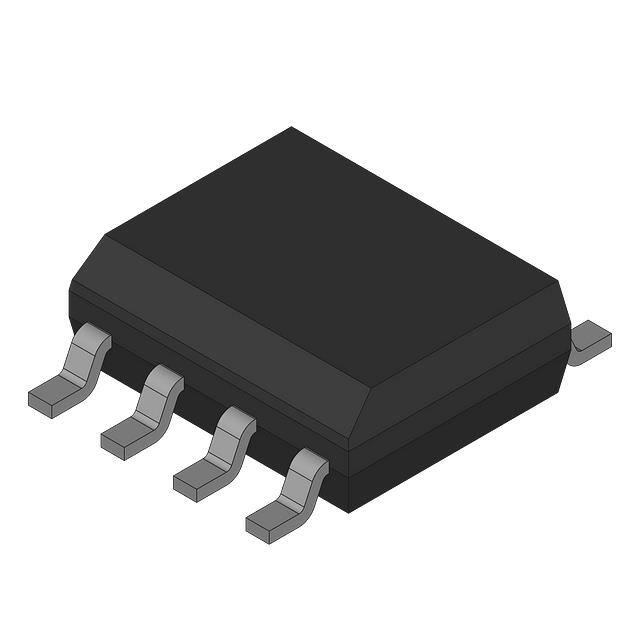Unveiling the secrets of car head-up display technology
The secret weapon for driving without looking down
Imagine that you are driving your car on the highway at a high speed, with cars whizzing by. At this time, the road conditions ahead are complicated and there are many forks, and you have to pay attention to the speed of the car at all times to avoid speeding, and pay attention to the navigation instructions to avoid missing the exit. In the traditional way, you have to look down at the dashboard and the central control screen frequently. Every short shift of vision is like burying an unstable "mine" for driving safety. If you are not careful, you may cause an irreversible accident because of that few tenths of a second of distraction.
But if your car is equipped with a car head-up display (HUD, Head - Up Display), the situation will be completely different. When you are driving on this highway, key content such as speed, navigation arrows, warning information, etc. are clearly projected on the windshield in front of you, perfectly integrated with the real road conditions. You no longer need to lower your head, your eyes can always focus on the road ahead, and all important information is clear at a glance, just like having an exclusive transparent "personal secretary" who can deliver key intelligence to you in a timely manner at critical moments, allowing you to make accurate responses in advance and successfully avoid potential dangers.
What is the secret of this magical car head-up display technology? How did it step into our car life step by step and quietly change the driving experience? Today, let us unveil its mysterious veil together.
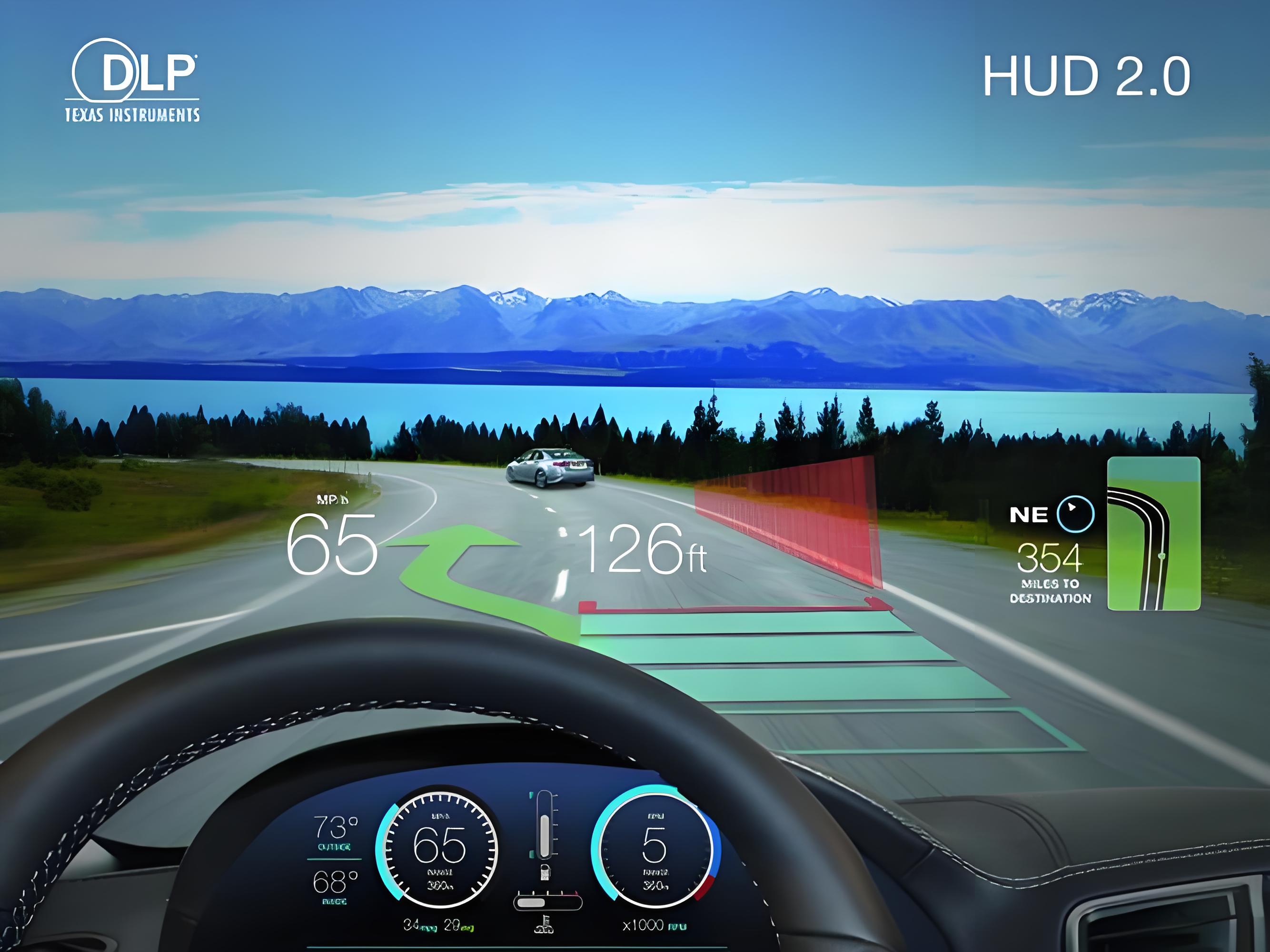
HUD first impression: What is it ?
The car head-up display, the English name is Head - Up Display, abbreviated as HUD, and its core feature can be seen from the name - let the information "look up" to display, so that the driver can get key information without lowering his head. It uses the principle of optical reflection to project various important information of the vehicle, such as speed, speed, fuel consumption, navigation instructions, driving assistance system prompts, etc., onto the windshield of the car through a specific device. This information is presented in the form of a virtual image in front of the driver, just like floating on the road in front of the front of the car, perfectly integrated with the real driving vision.
Imagine that when you are driving a vehicle on a city road and need to turn at the intersection ahead, the HUD will clearly project a striking turning arrow and the remaining distance to the turning intersection on the windshield, so that you can prepare for the turn in advance without diverting too much attention; or on the highway, you set the cruise control, the HUD will not only display the current speed, but also display warning information in time when the distance between the vehicle and the vehicle in front is too close, reminding you to keep a safe distance. The existence of HUD is like building a "high-speed bridge" between the driver and vehicle information, greatly shortening the time and energy cost of obtaining information, making the driving process smoother and safer.
The development of automotive HUD
In 1988, General Motors took the lead in applying HUD technology to the automotive field and launched the Oldsmobile Cutlass Supreme Indy 500 Pace Car model equipped with HUD. This initiative is like throwing a stone in the field of automotive technology, stirring up layers of ripples. Before this, drivers could only rely on traditional dashboards to obtain vehicle information, and they had to look down frequently, which was inconvenient and posed a safety hazard. The emergence of HUD allows drivers to easily obtain key information without diverting their sight, and the driving experience has been qualitatively improved.
Since then, more and more automakers have followed suit, and HUD has gradually moved from the exclusive configuration of high-end models to a wider automotive market. The early automotive HUD functions were relatively simple, mainly displaying basic information such as vehicle speed and rotation speed, and the imaging effect and display accuracy needed to be improved. However, with the continuous advancement of technology, the functions of HUD are becoming increasingly rich. It can not only display navigation information and driving assistance system prompts, but also the imaging quality is becoming clearer and more stable.
In recent years, AR-HUD (augmented reality head-up display) has begun to emerge. On the basis of traditional HUD, it incorporates augmented reality technology, integrates vehicle information with real road conditions, and presents it to the driver in a more intuitive and three-dimensional way. For example, when navigating, AR-HUD can project virtual navigation arrows directly onto the actual road, so that the driver can know more clearly which intersection to turn at; when the vehicle turns on the adaptive cruise function, AR-HUD will display the distance to the vehicle in front and the driving status of the vehicle in real time, making the driving process safer and smarter. Models such as Mercedes-Benz S-Class, Hongqi E-HS9, and Weipai Mocha are equipped with advanced AR-HUD technology, bringing users a new driving experience.
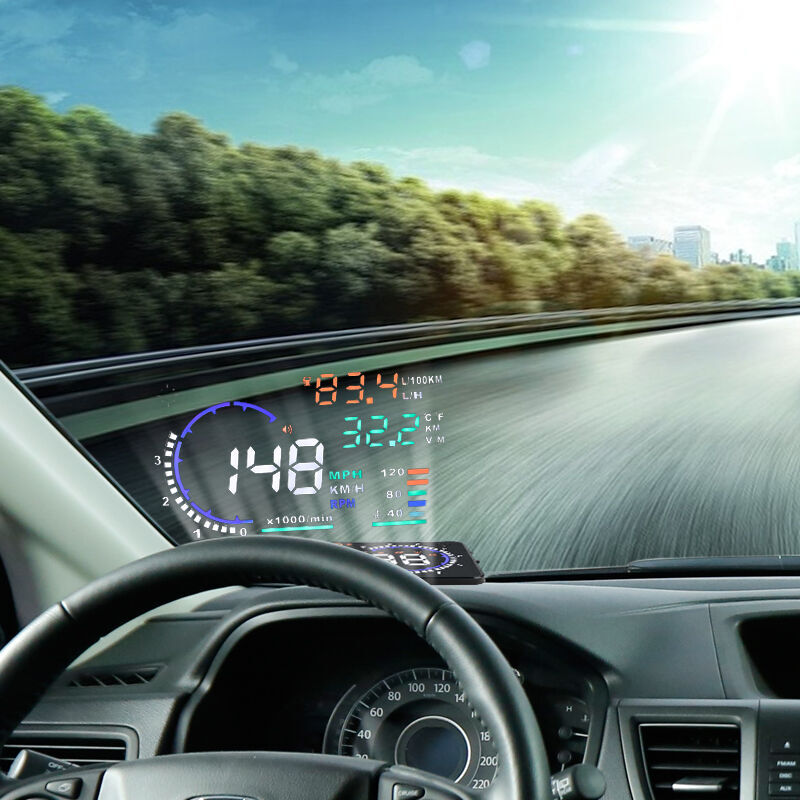
Working principle revealed: the magic of light and shadow
(I) Core components
The working principle of HUD is full of technological charm. It is mainly composed of two core components working together, namely the picture generation unit (PGU, Picture Generation Unit) and the optical display system.
The image generation unit is called the "brain" of HUD, responsible for generating images of various vehicle information. It is like a sophisticated "image factory" that contains a series of optical components such as light sources, lenses, and diaphragms. Taking the common PGU based on thin-film transistor liquid crystal display technology (TFT-LCD) as an example, its working process is like an orderly "light and shadow dance". When the LCD screen is illuminated by the backlight source, the thin-film transistors behind each pixel begin to play a role. They are like precise "little helmsmen" that drive the liquid crystal molecules to rotate and cleverly change the polarization state of the light source, thereby presenting different light and dark grayscales. After that, these lights are converted into colorful image information through the RGB color filter, such as vehicle speed, rotation speed, navigation instructions, etc., which can be accurately generated here. The optical display system is like a magical "projector", shouldering the task of projecting the image generated by the PGU clearly and accurately onto the windshield in front of the driver. It mainly includes key optical components such as the primary reflector, the secondary reflector and the windshield. The image information generated from the PGU will first be projected onto the primary reflector, just like the first baton in a relay race. The primary reflector reflects the image to the secondary reflector, which further reflects and adjusts the image, and finally enlarges the image and displays it in front of the front windshield. At this time, the driver sitting in the driver's seat can see the clear image projected in the distance at the eye box, as if the information is floating on the road in front of the car.
(II) Reflection imaging
HUD uses the principle of optical reflection to reflect the image information generated by PGU through a series of reflectors and finally project it into the driver's field of vision in front of him, forming a clear virtual image. When the PGU generates an image, the light will first hit the reflector, which will reflect the light to the projection mirror at a specific angle. In order to adapt to the curved shape of the windshield and avoid image deformation, the reflector and the projection mirror are usually designed into a special curved shape.
After the light is reflected again by the projection mirror, it is projected onto the windshield. The windshield is like a huge "canvas" that receives and reflects these lights, allowing the driver to see the virtual image at a specific distance in front of his eyes. Generally speaking, this virtual image is about 2-2.5 meters away from the driver, giving the feeling that the information is floating on the road ahead. Moreover, the position of the HUD image on the windshield can be adjusted. The key is that by adjusting the angle of the projection mirror, the image position can be moved up and down, left and right to meet the viewing needs of different drivers.
Full analysis of types: each showing its own magic
At present, there are three main types of automotive head-up displays, namely C-HUD (combined head-up display), W-HUD (windshield head-up display) and AR-HUD (augmented reality head-up display). They have their own advantages and play a unique role in different market needs.
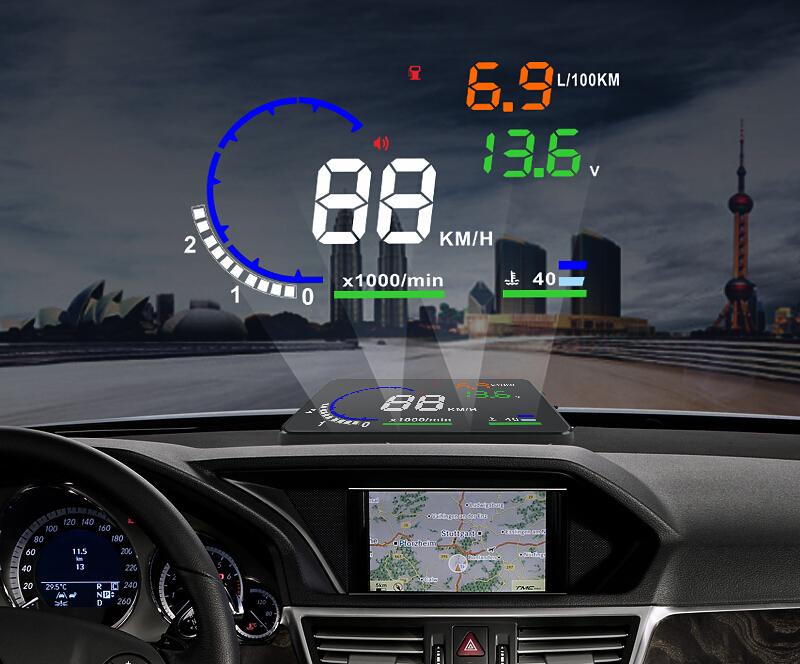
(I) C-HUD
C-HUD, that is, combined head-up display, uses translucent resin glass as the imaging carrier. This type of HUD has a relatively low cost and is very convenient to install. Some car owners will choose to buy it and install it on the vehicle by themselves. However, it also has obvious shortcomings. Since the imaging carrier is a small piece of translucent resin glass, the imaging area is small and the information that can be displayed is very limited. Generally, only basic information such as vehicle speed and rotation speed can be displayed. Moreover, when the vehicle collides, this external resin glass has the risk of causing secondary injury to the driver, so there are certain hidden dangers in safety. Nowadays, with the development of technology and the improvement of consumers' requirements for display effects, C-HUD has gradually been marginalized by the market, and many new cars rarely use this type of HUD in configuration selection.
(II) W-HUD
W-HUD, that is, windshield head-up display, directly uses the front windshield of the car as an imaging carrier. Compared with C-HUD, W-HUD has a more integrated display and better imaging effect. It can clearly project vehicle information on the windshield, which perfectly integrates with the driver's forward field of view, making the driver feel as if the information is floating on the road ahead. The information it displays is also richer. In addition to the basic vehicle speed and rotation speed, it can also display navigation instructions, driving assistance system prompts and other information. However, W-HUD is not perfect. On the one hand, the shape and curvature of the windshield will have a certain impact on the imaging. In order to ensure the imaging quality, it is necessary to design a special high-precision aspheric reflector for the size and curvature of the windshield, which makes it more expensive. On the other hand, although its display range is larger than that of C-HUD, it still has certain limitations in the imaging range and the richness of the displayed information, and cannot meet the needs of some users who have higher requirements for display effects. At present, W-HUD is a type of HUD that is widely used in the market, and many mid-to-high-end models use it as an important configuration option.
(III) AR-HUD
AR-HUD, or augmented reality head-up display, is the "leader" in current HUD technology. It also uses the windshield as an imaging carrier, and its biggest highlight is that it can realize the integration of vehicle information and real scenes. Through the front radar and camera and other equipment to collect the data of the external environment, and then through the precise calculation of the AR algorithm, the vehicle information is accurately superimposed on the real road scene in the form of a virtual image. For example, when navigating, it can project the virtual navigation arrow directly on the corresponding position of the actual road, so that the driver can know where to turn more intuitively; when the vehicle turns on the adaptive cruise function, it can display the distance to the vehicle in front and the driving status of the vehicle in real time. AR-HUD has a large screen and a long imaging distance, usually up to 7 meters or even farther. This allows the driver to obtain information without frequently switching the focus between the real scene and the displayed information, greatly improving the safety and comfort of driving. However, AR-HUD also faces some challenges. Its technical complexity is high, its volume is large, and its manufacturing cost remains high, which to a certain extent limits its popularity. However, with the continuous breakthrough of technology and the gradual reduction of costs, AR-HUD is expected to become the mainstream development direction of automotive HUD in the future. The AR-HUD equipped on models such as Mercedes-Benz S-Class and Huawei M9 has brought users a very technological and practical driving experience.
Application scenarios and advantages: Driving will never be the same
(I) Navigation guidance
In daily driving, accurate and timely navigation guidance is essential. AR-HUD has shown unique advantages in this regard. It perfectly integrates navigation information with real scenes, bringing drivers an unprecedented navigation experience. When you are driving on unfamiliar city streets and preparing to go to your destination, AR-HUD will clearly project virtual navigation arrows on the windshield. These arrows seem to be marked on the actual road and integrated with the surrounding environment. You no longer need to struggle to find the turning direction on the mobile phone map or the central control screen. You can easily make turning decisions based on the intuitive navigation arrow instructions in front of you, greatly reducing the probability of missing the intersection.
Taking the AR-HUD equipped with the Mercedes-Benz S-Class as an example, when navigating on complex urban roads, it can accurately project navigation information onto the windshield. The virtual arrows are highly consistent with the real road. The driver can easily keep up with the navigation instructions during driving, as if there is a caring navigator guiding in real time. This way of combining navigation information with real scenes not only improves the accuracy and ease of use of navigation, but also makes the driving process smoother and safer.
(II) Safety Assistance
HUD plays a key role in improving driving safety. It can display ADAS (Advanced Driver Assistance System) information in real time, allowing the driver to understand the safety conditions around the vehicle in a timely manner and take countermeasures in advance. When there is a potential collision hazard in front of the vehicle, the HUD will quickly display a striking collision warning message, which may be a flashing red warning icon, or a striking text prompt, and may also be accompanied by a sound alarm to remind the driver to take braking or evasive measures immediately.
In terms of lane departure warning, when the vehicle unconsciously deviates from the lane, the HUD will display lane departure warning information on the windshield, such as a flashing yellow warning line near the lane line, or by vibrating the steering wheel, sounding an alarm, etc., to remind the driver to correct the direction in time to avoid traffic accidents caused by lane departure. For example, the AR-HUD of Volkswagen ID.4 CROZZ has safety assistance functions such as lane departure, collision warning, following distance and pedestrian prompts. In actual driving, these functions are like putting a layer of "safety armor" on the vehicle, greatly improving driving safety.
(III) Improving driving experience
HUD reduces the number and time of the driver's line of sight diversion, making the driving process easier and more convenient. In traditional driving mode, the driver needs to frequently look down at the dashboard and central control screen to obtain information such as vehicle speed and navigation, which not only distracts attention but also increases driving fatigue. With HUD, the driver only needs to keep his eyes level ahead to easily obtain all key information. The line of sight does not need to frequently switch between different devices, and the driving process is more focused and smooth.
At the same time, the emergence of HUD also adds a strong sense of technology and immersion to the cockpit. When you sit in a car equipped with HUD and start the vehicle, all kinds of information are clearly projected on the windshield in front of you, just like the scenes in science fiction movies, creating a futuristic driving atmosphere. In particular, AR-HUD perfectly integrates virtual information with real road conditions, making the driver feel as if he is in a driving space full of technological charm, greatly enhancing the fun and experience of driving. For example, in some high-end models, the HUD display effect is exquisite and colorful, which complements the luxurious interior of the vehicle and brings the ultimate driving enjoyment to users.

Market and development trends: The future has come
(I) Market status
At present, the HUD market is showing a booming trend. According to the monitoring data of Gaogong Intelligent Automobile Research Institute, in 2023, 2.2543 million new cars with W/AR HUD pre-installed as standard will be delivered in the Chinese market (excluding imports and exports), a year-on-year increase of 50.26%, and the penetration rate exceeded the 10% mark for the first time. This data shows that HUD is gradually moving from the "exclusive configuration" of high-end models to a wider automotive market. Among them, the performance of independent brands in HUD installation is particularly eye-catching, with the contribution of delivery accounting for more than 60%, becoming the main force of W/AR HUD pre-installed standard configuration.
Taking some popular models as an example, BYD Han and Tang series, by equipping with advanced HUD technology, provide users with a convenient driving experience and let more consumers recognize the advantages of HUD. In 2024, many new cars of independent brands will use HUD as an important configuration, further promoting the development of the HUD market.
(II) Technical breakthrough direction
In terms of display technology, technologies such as LCOS (liquid crystal on silicon) and LBS (laser scanning projection) are gradually emerging and showing broad application prospects. LCOS technology has attracted more and more attention due to its advantages such as high resolution, high contrast and low power consumption. Huawei applied the LCOS solution in the M7/M9 model, which led to a rapid increase in the shipment volume of AR-HUD products of this solution. Many companies, such as Crystal Optoelectronics and Huayang Group, have demonstrated LCOS prototypes, further promoting the development of this technology. LBS laser projection technology has also begun to emerge in the field of in-vehicle display. Its MEMS Mirror LBS technology has brought new possibilities for in-vehicle display with high efficiency, high contrast and flexible projection capabilities. With the continuous advancement of technology, these emerging technologies are expected to become the mainstream solutions of the HUD industry in the future, further improving the display effect and performance of HUD.
Optimization of optical design is also an important direction for HUD technology breakthroughs. With the development of AR-HUD, free-form mirrors have become key components, which can better adapt to the shape of the windshield, reduce image distortion, and improve imaging quality. Injection molding solutions dominate the mass production of free-form mirrors, and have advantages in cost and consistency. At the same time, 3D glass manufacturers are also actively entering the field of free-form mirrors. For example, Corning's glass free-form surface has been used in Hyundai Anik 5. Domestic manufacturers such as Yutong Optics and Lily Optoelectronics have also launched their own products, and are expected to make more breakthroughs in this field in the future.
(III) Cost and Popularization
Cost is one of the key factors affecting the popularity of HUD. At present, the cost of AR-HUD is relatively high, which to a certain extent limits its large-scale popularization. However, with the continuous maturity of technology and the expansion of market scale, the trend of cost reduction is very obvious. On the one hand, with the increase in HUD market penetration, the scale effect will gradually emerge, and the cost of production and manufacturing will continue to decrease. On the other hand, technological progress will also drive down costs. For example, the application of new display technologies and the optimization of optical design will help improve production efficiency and reduce production costs.
When costs are reduced to a certain extent, HUD is expected to become a standard feature of cars, just as popular as today's in-car navigation. By then, more consumers will be able to enjoy the convenience and safety brought by HUD, which will further promote the intelligent development of the automotive industry.
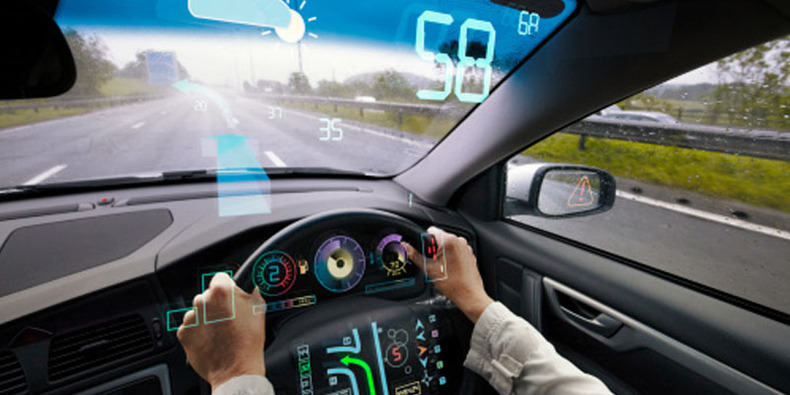
Summary and Outlook: Driving into the Future
As a key link in the process of automotive intelligence, automotive head-up display technology is profoundly changing the way we drive. From the initial C-HUD to the now highly anticipated AR-HUD, every technological innovation is constantly improving driving safety, convenience and comfort. It not only reduces the safety hazards caused by the driver's line of sight diversion, making key information within reach, but also brings us a driving experience full of technology, making driving easier and more enjoyable.
Looking to the future, with continuous breakthroughs in display technology, optical design and other aspects, HUD technology is expected to usher in a more brilliant development. The reduction in costs will make it more popular, become a standard feature of more models, and benefit more consumers. At the same time, we expect HUD to be deeply integrated with more advanced automotive technologies, such as autonomous driving technology and vehicle networking technology, to create a more intelligent, safe and convenient travel future for us.
As witnesses and experiencers of the development of automotive technology, let us pay attention to the development of HUD technology and look forward to it bringing us more surprises in the future, so that every trip can become a safe and comfortable technological journey.

